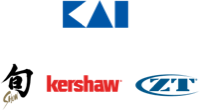We use cookies to make your experience better. To comply with the new e-Privacy directive, we need to ask for your consent to set the cookies. Learn more.

Automatic Knife Release Form
You must read and fill out this form before Kai USA, Ltd. can sell to you, or ship to you, any Automatic or Butterfly Knives. By electronically signing this online form, you confirm that you are in compliance with the federal statutes shown below as well as any applicable state and local regulation.
By placing an order or receiving a product service (such as warranty repair service) from us, you agree that you meet any or all of the following criteria:
APPLICABLE FEDERAL STATUTES
18 U.S.C. § 1716 (G) (2) (1-4) provides, in summary:
Switchblade (automatic) knives can be shipped to civilian and armed forces supply or procurement officers and employees of the federal government ordering or procuring or purchasing such knives in connection with activities of the Federal government; to supply or procurement officers in the National Guard, the Air National Guard or militia of the state or territory of the District of Columbia ordering, procuring or purchasing such knives in connections with the activities of such organizations; to supply or procurement officers or employees of the municipal government of the District of Columbia or the government of any state or territory of any county, city or other political subdivision of a state or territory ordering, procuring or purchasing such knives in connection with the activities of such government.
15 U.S.C. § 1244 provides, in summary:
Knives can be shipped by common carrier; that sale, transportation or distribution, possession or introduction into interstate commerce of switchblade knives is authorized if it is pursuant to a contract with the armed forces; or, any member or employee thereof acting in the performance of his or her duty may possess switchblade knives and may have them shipped to him and sold to him or her. The possession and transportation upon his or her person of a switchblade knife or a blade 3 inches or less is authorized to any handicapped individual who has the use of only one arm.
STATE LAW PROVISIONS
It would be impossible to provide an exhaustive review of the laws that may apply in the various fifty states and in the various counties, parishes, municipalities, and other political subdivisions within each state. By signing this form below, you will be certifying that in addition to complying with federal law, you have determined which, if any, state or local laws apply to you, and that you are acting in compliance with those laws.
No Post Office Box addresses can be used on this form. Item(s) must be sent in going UPS or Fed Ex. No USPS shipments will be accepted. If the address that you have filled out on this form is no longer a valid address, you must contact us and fill out a new form.
f-18 form successfully submitted
A confirmation will be sent to your email shortly. You can find your signed form in your Account.
Please note, you cannot add to cart without signing the f-18 agreement


- 1800 SW Teton Avenue
- Tualatin, OR 97062
- Phone: 503-682-1966
- Toll Free: 800-325-2891
- Fax: 503-682-7168
- kaiusa.com
Sharpening Service
SHARPENING FOR THE HOLIDAYS
If you want your knives tuned-up for the holidays, please send them in soon! Our sharpening team gets increasingly busier as the holidays approach.
To receive your sharpened knives by Thanksgiving we need to receive them by November 1st.*
To receive your sharpened knives by Christmas, we need to receive them by December 1st.*
*Processing, shipping, and handling times are approximated and not guaranteed.
Ever wonder what happens to your knife when you send it in for sharpening? How do we fix a broken tip, anyway? How long will I be without my beloved knives?
You’ve got questions, we’ve got answers. Plus, some tips for always getting the most from your beautiful knives.


Inspect your knives every time you use them.
Check it for cracks, chips, or rust. If you spot any of these things, send it to us for a thorough inspection. The sooner you spot it, the easier it will be to solve. Learn how to inspect your knives.
Service is free
We will sharpen your Kai cutlery for free, for as long as you own it. You pay for shipping & processing, our sharpening services are FREE. Learn more about our sharpening service.
Walk-in service
If you are in the Portland metro area, you may also bring your Kai knives in for free sharpening. Learn more about walk-in service.
Before sharpening, try honing.
Even though your knife may feel dull, it may not need sharpening. As you use your knife your edge rolls over to one side or the other. This is normal. Honing straightens out a rolled edge.
A honing steel enables you to re-align the edge so that the razor-sharp edge is once again gliding through the food as you cut. To hone, align the flat side of the blade with the 16° angle guide on the hand guard of your Shun honing steel. Maintaining that angle, gently pull the blade down the steel from heel of blade to tip. Some cooks hone once a week, some hone every day depending on usage. Learn more about sharpening vs honing.
When your knife is dull and honing no longer provides improvement, it’s time for sharpening. You can send it to us for sharpening, or we offer a variety of tools to sharpen on your own. Shop sharpening and honing tools.


A cutting edge can roll to one side or the other, and varies along the blade. Honing can straighten this out, as long as it isn’t too severe, making your knife feel sharp again.
Dull edge? Broken tip?
We can help.
There are a number of reasons why a knife tip might break, or the blade chips—apart from accidentally dropping it on a hard surface. Learn more about your knives at our FAQ page.
Good news - we can sharpen it back to a pointy tip, or a flat edge! Rolled edge that honing can’t correct? We can fix that too.
We re-sharpen your knives on the same type of sharpening wheel used to put the original edge on the knife. Called a hiromai, it is a horizontal wheel that uses a wet sharpening method to protect the knives from over-heating during sharpening, so they retain their tempering.
Because sharpening removes metal from your knife, your blade will look different than it did originally. This is normal and to be expected.
For standard sharpening it removes very little blade material. But to repair a broken tip, or chipped blade we have to remove more material to bring it back into shape.


Repair a broken tip
To re-form a broken tip, we must remove material from both the spine and cutting edge. This means your repaired blade will have a slightly different shape and be shorter than it was originally.
Repair a chipped edge
We can sharpen out small chips (2mm or under). To do so, we need to remove all the metal in line with the chip making your blade narrower than it originally was. This should not affect its performance. The cutting edge will be thicker so it may not feel as sharp as brand new, but it will be precisely the same cutting angle. Severe chips or cracks that extend into the cladding may not be repairable.
If you have any questions for our warranty and sharpening team, please email us at warrantyinfo@kai-usa.com


Why did this happen to my knife?
There are several things that can cause damage to your knife from improper cutting surface to micro-corrosion. Learn more about your knives at our FAQ page.
Do you sharpen shears/scissors?
We’re sorry, but our warranty service center does not have the proper equipment to successfully sharpen scissors/shears. However, we would be happy to hone any of the shears Kai USA sells. Honing simply brings the edge back to true; it does not remove metal from the shears.
If your shears have grown dull or the edges are damaged, we recommend looking for an experienced shear sharpener in your area.
If you have Kasho professional hair shears, please send them to Kasho for sharpening. Learn more at their website.
If you have Kai textile shears, please take them to a experienced shears sharpener in your area.


Do you sharpen serrated knives?
We’re sorry, but our warranty service center does not have the proper equipment to successfully sharpen serrated knives. However, we would be happy to hone them for you. Honing simply brings the edge back to true; it does not remove metal from the blade.


If you have any questions, please call our Warranty Service Team toll-free at 1-800-325-2891 or email us at warrantyinfo@kai-usa.com.
Do my knives need sharpening?
Q: Sharpening or honing?
A: You already know the basics of fine knife care: handwash, dry thoroughly, use an appropriate cutting surface and cutting technique. Regular honing helps retain your knife’s performance, too. Why? Because of what is called a rolled edge.
Q: What is a rolled edge?
A: Every time your knife contacts the cutting board, there’s an impact on the blade. Over time, the thin edge of the blade will naturally curl over. This is called a “rolled edge.” The edge is still sharp, but the sharpest part is no longer what is moving directly through the food as you cut, so it feels dull.
Use a honing steel to re-align—or uncurl—the edge so that the razor-sharp edge is once again gliding through the food. Depending on how often you use your knives, you could hone them weekly or monthly. When honing no longer brings the “sharp” back, it’s time to sharpen.
Q: What are the signs that I should send my knives in for sharpening?
A: If you notice any of the issues below, your knives will need sharpening. Especially in the case of micro corrosion, the sooner you spot it, the easier it will be to solve. Inspect your knives often.
- Reduced performance—even after honing, the edge won’t easily glide through the resilient skin of a tomato
- Reduced performance on part of the blade—the part of the blade you use most (usually the center) no longer cuts as well, but the tip and heel may still be sharp
- Micro corrosion on edge or blade—such as rust (see more below)

